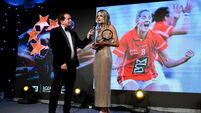Cathal Dennehy: If women's sport isn't based on biology it becomes an unwinnable race

NEW REGULATIONS: World Athletics President Sebastian Coe during the Wanda Diamond League Series London Athletics Meet at the Queen Elizabeth Olympic Park, London. Picture date: Saturday July 19, 2025. PA Photo. Photo credit should read: Adam Davy/PA Wire
In the end, it comes down to a simple question: What is a woman?
Across the world, and probably within your social circle, there are various answers to that. Many see it as a straightforward, biological term, that being a woman is the preserve of those with XX chromosomes and female reproductive organs. For others, it’s broader, the definition based more on identity – not so much the physical composition of a body, but what someone feels and believes in their mind.
This is a discussion that can rarely be had without toxicity, or political allegiances, making their presence felt. If you want an easy way to end a conversation, then ask a co-worker what a woman is and how their definition should be applied and implemented – from changing rooms to prisons to the playing fields of sport.
Many won’t answer due to an understandable fear of causing offence, or not wanting to be grouped with radicals on the far left or right of this topic, who so often back their beliefs with unnecessary nastiness.
For several decades, sport has been struggling with this question – unable to work out its answer but becoming ever more aware of the need to do so. But the governing bodies that sat on their hands, unwilling to enter such difficult waters, have recently been left with no choice but to get their policies in order and choose what they will prioritise in women’s sport: inclusion or fairness?
Because both can’t coexist at once – at least not fully.
On Wednesday, World Athletics announced that its council had approved new regulations concerning eligibility for the female category that will come into effect next month.
“All athletes wishing to compete in the female category at the World Championships are required to undergo a once-in-a-lifetime test for the SRY gene – a reliable proxy for determining biological sex,” it stated. “This is to be conducted via a cheek swab or blood test, whichever is more convenient.”
As its president, Sebastian Coe, put it: “We are saying, at elite level, for you to compete in the female category, you have to be biologically female … gender cannot trump biology.” National federations will oversee the testing protocol, with World Athletics contributing $100 towards the cost of testing each athlete ahead of next month’s World Championships in Tokyo.
Most in athletics welcomed the news. But not all. Nikki Hiltz, a world-class US 1500m athlete who was born female and competes in the women’s category but who identifies as non-binary, posted on Instagram that it was “INSANE”.
“My biggest concern is if these are now the rules at the top of our sport, how will they trickle down to the lower levels?” they wrote. “How will this affect women in the NCAA? Girls in high school? Young athletes in track and field youth programs? Will their tests also be a ‘harmless’ cheek swab or something far more invasive?”
Such concerns are understandable, given the history in this sphere. In the 1950s, eligibility for the female category was sometimes based on visual inspections, or so-called ‘nude parades’, which were not only humiliating but also unreliable. That was replaced by less invasive methods like basic chromosome screening in 1968.
Mandatory sex testing was abolished in 1999 but now it’s back, and this is a very different time, with a one-off cheek swab now all that’s required to identify athletes who are biologically male. In an editorial for the Scandinavian Journal of Medicine and Science in Sports last year, sports scientist Ross Tucker and a horde of other experts in this field called for such screening, stating that “an early, cohort-wide approach that treats all participants equally is overwhelmingly preferable to the current approach that invites targeted testing based on allegation, suspicion, subjective assessments, and bias.”
In May, World Boxing – the new global federation that governs the sport at Olympic level – announced it will implement mandatory sex testing at its competitions to “ensure the safety of all participants and deliver a competitive level playing field for men and women,” with boxers required to undergo a PCR genetic test to determine their sex at birth and check for a Y chromosome.
Athletics and boxing have drawn a clear, definitive line with these policies and other sports will likely follow suit. Of course, both had huge incentives to get their house in order when it comes to eligibility for the female category, with huge controversies playing out on the Olympic stage in the last decade concerning athletes who reportedly had a difference in sex development (DSD). Those with 46 XY DSD are sometimes labelled female at birth, especially in underdeveloped nations, due to a lack of external male genitalia, but their biology is male, with internal testes flooding their system with testosterone during puberty, conferring huge performance benefits in sport.
Still, the difference between the sexes is clear long before puberty. On average, males run faster than females at every age, with a study of elite US youth athletes finding a 5% performance difference in running events from ages 7-12, which widens significantly post-puberty, hitting 12% at age 18.
There is, of course, a key difference between transgender and DSD athletes in women’s sport. The latter are often labelled female at birth and on their passports and grow up as women, which is different to those labelled male at birth who feel that does not match their gender identity and wish to transition.
But ultimately, sport will probably have to treat them the same. Because both reap long-lasting performance benefits from male biology. The key question for authorities is not so much about transgender or DSD athletes specifically. If we accept that you need to clear a higher bar to compete in women’s sport than simply declaring yourself a woman, the question is what biological parameters should be met before you can do so?
Because women’s sport is, after all, a protected category, and for both safety and fairness it should be protected.
We know the most up-to-date evidence shows the performance advantages of being born male and going through male puberty are not eradicated, only reduced, by treatments to lower testosterone. We also know the majority of those in sport, and society, believe women’s sport should be protected.
Last year, the BBC surveyed high-level competitors across 28 sports and of the 143 respondents, just 11 said they feel comfortable or very comfortable about transgender women competing in the female category, while 104 felt uncomfortable or very uncomfortable.
Sport Ireland, in developing guidance for transgender and non-binary inclusion, surveyed several thousand people in sport and across society on this topic. One of the key findings: “While many from the LGBTI+ community, transgender and non-binary people and their families, are supportive of inclusion through self-identification, this view is not shared by the vast majority of people working and taking part in sport who favoured protection of a female category (as assigned at birth).” Many national governing bodies have followed the lead of global authorities in this sphere, and while there are countless approaches taken to govern access to the female category, the one-time cheek swab seems the most sensible.
Because if women’s sport isn’t based on biology, then the net result, as we’ve seen many times in the past, is natal females ending up in a race – or a fight – that they simply cannot win.








